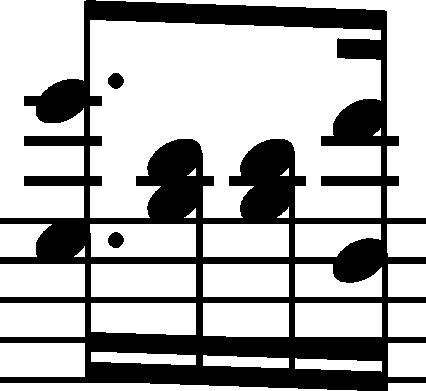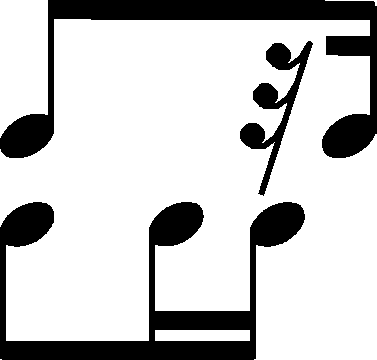



Rhythm
|
b. 13-15
|
composition: Op. 44, Polonaise in F♯ minor
..
In FE (→EE) the crotchet stems reach only the top notes of the R.H. octaves on the 2nd beat of b. 13 and 14; similarly, in b. 15 it is only the top notes of the octaves that are separated as the top voice on the 3rd beat (in turn, both notes of each of those octaves belong to the bottom voice). It must have resulted from a misunderstanding: Chopin's notation was misunderstood by the copyist or, which is more likely, by the engraver of FE. Chopin would always write stems on the right-hand side of noteheads, which would result in an ambiguous notation in such a situation, e.g. in b. 15: category imprint: Interpretations within context; Differences between sources issues: EE revisions , Errors in FE , Errors in GE , FE revisions |
||||||
|
b. 13-14
|
composition: Op. 44, Polonaise in F♯ minor
..
In the main text we suggest prolonging the separated R.H. octaves after the authentic notation in analogous situations in b. 37-40. We also suggest prolonging B category imprint: Editorial revisions issues: GE revisions |
||||||
|
b. 25
|
composition: Op. 44, Polonaise in F♯ minor
..
In EE1 the quaver beaming of the last two L.H. octaves was overlooked. The patent oversight was corrected in EE2 (→EE3). category imprint: Interpretations within context; Differences between sources issues: EE revisions , Errors in EE |
||||||
|
b. 29
|
composition: Op. 44, Polonaise in F♯ minor
..
We give the rhythm of the 1st crotchet in the bar after the rhythmically correct version of GE, conveying almost certainly the text of [A]. FE1 contains an erroneous rhythm missing one demisemiquaver – category imprint: Differences between sources issues: Errors in FE , FE revisions |
||||||
|
b. 31
|
composition: Op. 44, Polonaise in F♯ minor
..
FE1 overlooked a quaver flag to the 2nd R.H. octave, f-f1. The mistake was repeated in EE1, and also omitted were the dots prolonging the e category imprint: Interpretations within context; Differences between sources issues: EE revisions , Errors in FE , Errors in EE , FE revisions , Errors repeated in EE |

 . The fact that Chopin meant to prolong both notes of the octaves is evidenced by the dots prolonging both notes in
. The fact that Chopin meant to prolong both notes of the octaves is evidenced by the dots prolonging both notes in  in b. 13, since there is no visible reason to approach that note differently than the R.H. octave (this figure does not appear in the Polonaise in this form anymore).
in b. 13, since there is no visible reason to approach that note differently than the R.H. octave (this figure does not appear in the Polonaise in this form anymore). (the scheme preserves the alignment of the R.H. part with respect to the L.H. part). According to us, it is most probably an unfinished notation of the rhythm we can see in
(the scheme preserves the alignment of the R.H. part with respect to the L.H. part). According to us, it is most probably an unfinished notation of the rhythm we can see in  -e
-e